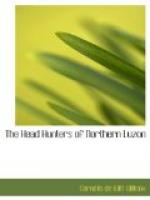This country was first visited by Mr. Worcester in 1906. The Spanish Government never having succeeded in gaining a foothold in it. “During the insurrection Lieutenant Gilmore, of the United States Navy, and his fellow-captives were taken into the southern part of it and there abandoned.” “So far as is known, no white man had ever penetrated the southern and central portions of Apayao until” Mr. Worcester, suitably accompanied and escorted, crossed the Cordillera, in 1906, from North Ilokos. A later expedition, commanded by a Constabulary officer, was attacked, not necessarily from any hostility to it as such, but because it was accompanied by natives hostile to a rancheria (Guenned) approached on the way. A punitive expedition, led by the same officer, afterward met with some success, but American popularity suffered in consequence. The Apayao country is the only sub-province under a native Governor, and its Governor, Senor Blas Villamor, is the only Filipino that has ever shown any interest in or sympathy for the highlanders. His task has been a difficult one; for example, his only line of communication, the Abulug River, runs through a territory inhabited by Negritos, who had been so abused by the Christian natives on the one hand, and whose heads had been so diligently sought by the wild Tinguians of the mountains, on the other, that they had acquired the habit of greeting strangers with poisoned arrows. His mountain region itself was inhabited by inveterate head-hunters, most of whom had never even seen a white man. Conditions are improving, however; the raids against the Christian and Negrito inhabitants of the lowlands of Cagayan have been completely checked, and Mr. Worcester hopes that head-hunting will diminish. It still exists. Strong told me, on his return to Manila, that, looking into a head-basket after leaving Tabuk, he found in it fresh fragments of a human skull; for the Apayaos take the skull like the other highlanders, but unlike them, break it into pieces. But with these people head-hunting is a part of their religious belief, and so all the harder to uproot. With the others it is a matter of vengeance, or else even of sport. “On the other hand, the people of Apayao have many good qualities. They are physically well-developed and are quite cleanly. They erect beautifully constructed houses. Their women are well clothed, and both men and women love handsome ornaments. They are quite industrious agriculturists and are now begging for seed and for domestic animals in order that they may emulate their Christian neighbors in the raising of agricultural products.”




